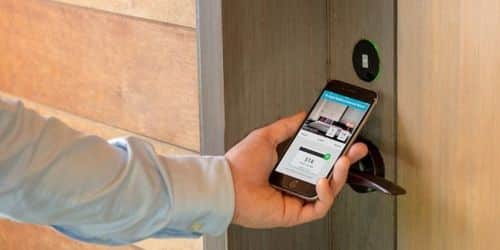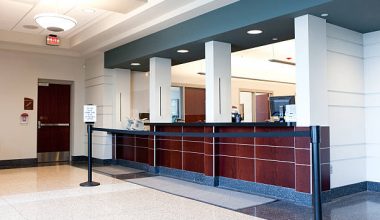Keyless entry systems, as the name implies, allow entrance to a restricted location without the use of a physical key. They are available in a wide variety of forms. There are many ways in which keyless entry systems can reduce costs for organizations, resulting in a speedy payback. You can change its code anytime you feel like changing it, to avoid unauthorized access. In this article, you will get to know the keyless entry systems that best fit the door entry in your small or large business.
Keyless Entry Systems for Business
The increasing demand for top-notch business building security has led to a plethora of keyless entry system options. It’s important to consider a company’s size, security budget, and desired system capabilities when deciding on the best keyless commercial entry system. Most business establishments use one of the following keyless entry systems:
#1. Key fobs
RFID key fobs can be used to unlock keyless door locks in the workplace in much the same way that key cards are used to unlock doors. The compact size and portability of key fobs make them a practical accessory for everyone who uses a keychain.
#2. Biometrics
For further security, some companies require their employees to present even more stringent credentials whenever they log in. Fingerprint readers, facial recognition software, and iris scanners are all examples of biometrics. When it comes to access control, biometric credentials are frequently employed as a second, secondary type of identification in addition to a standard credential like a key card or ID badge. Organizations can improve safety by using the phone’s biometrics with mobile access control.
#3. Proximity key cards
Key cards or fobs are used as entry keys in this prevalent type of commercial keyless entry system. These days, many businesses use proximity cards (or prox cards) in place of traditional ID badges. These credentials, about the size of a credit card, are simple to use and affordable. For maximum safety, commercial buildings that use key cards should only accept encrypted smart cards from tenants.
#4. Remote monitoring and control of buildings
When using this form of keyless access, your smartphone serves as your key. As it provides more convenience and, in many cases, a higher level of security than traditional forms of keyless door entry for businesses, app-based access control is swiftly rising in popularity. One benefit to using smartphones instead of key cards is that they require a less initial investment on the part of enterprises.
#5. Video-enabled keyless entry
In addition to the convenience of keyless entry, video readers add visible verification of each and every access event at the point of entry. If you’re looking for a video door reader for your business, be sure it works with high- and low-frequency RFID key fobs and cards, as well as mobile devices, for convenient keyless entry. Security personnel can check in on who’s trying to get in from wherever they happen to be thanks to remote access to the camera footage, reducing the risk of false positives, compromised credentials, and tailgaters.
#6. Hybrid keyless door entry systems
While mobile-based access control has its advantages, there are still businesses that require a keyless door entry system that is compatible with encrypted key cards.
Advantages of keyless entry systems for your business
Some merits of using keyless entry systems for our business doors are:
#1. Improved safety
There are better and more modern ways to keep a business safe, and metal keys are easy to misplace, copy, and forget about.
#2. Easy to handle.
When an employee retires, typical office locks require new keys to be cut and issued and the retooling of all door locks.
#3. Remote entry
Gain the convenience of remote entry management with a keyless entry system that is hosted on the cloud. With this function, businesses with multiple locations can coordinate their operations more efficiently.
#4. Increased awareness and control
The keyless entry system may be monitored and managed remotely using configurable dashboards that are mobile-friendly.
#5. Additional data insights
Neither the time nor the identity of the door’s previous user can be ascertained with a conventional key. It’s extremely difficult to audit and a compliance headache. You have access to more information than ever before with keyless entry systems thanks to the encrypted connection used to verify individual credentials.
#6. Future-proofing
When it comes to commercial buildings, keyless entry is about more than just convenience. As a result of their higher flexibility, mobile, cloud-based technologies allow businesses to better respond to the dynamic nature of their customers’ needs.
Keyless Entry Systems for Small Business
However, security has also undergone revolutionary changes alongside your company. Here are the top three keyless entry systems to door locks for a business setting that we endorse.
#1. Electronic Keyless Lock
Access control through keypad and proximity cards are two of this product’s primary features. It also supports the SC1 Keyway override options that are industry standards. This is one of the keyless entry door lock systems which is ideal for rental business properties with frequent occupant changes. Spend little more than necessary on new locks, keys, or rekeying! This keyless lock, finished in sleek satin chrome, is protected from the elements and offers maximum security thanks to the ability to frequently change its PIN.
#2. Ultraloq UL3 BT Bluetooth Enabled Fingerprint and Touchscreen Keyless Smart Lock
This 5-in-1 Bluetooth-enabled lock is the pinnacle of keyless security, allowing for access by fingerprint recognition, numeric code activation, smartphone control, and knock/shake to open.
Bluetooth technology is used by both iOS and Android users to control their smartphones. Even further, you can check in on the various people who have access, keep tabs on the activity log, and clone existing files. The Ultraloq fingerprint screen is equipped with cutting-edge technology that can recognize up to 95 different fingerprints in less than half a second. The numeric touchscreen supports 4-digit through 8-digit codes and can save up to ninety-five different passcodes. Whether you plan to use it indoors or outdoors, you won’t have to worry about the weather or dust thanks to the Zinc Alloy construction and hidden key on the bottom.
#3. Samsung Digital Door Lock
This Samsung digital door lock, one of the keyless entry systems is a great way to improve the safety and aesthetics of your business. Up to 31 RFID tags and users can be set up with this product. It’s simple to use but difficult to get into thanks to the digital touchscreen keypad, push-to-enter/pull-to-exit function, and automatic locking via mortise sensor. The mortise sensor is more sturdy than the standard cylindrical deadbolt, although it does necessitate a minor alteration to the door or door frame. The electronic locking mechanism makes it easier to open and close quickly while also providing the security of a latch.
The retail, restaurant, hotel, and high-security industries are just some of the many that would benefit from this lock. Extensive testing has shown this lock to be resistant to kicks and fires according to the PSB standard. It also contains a random security code function, an intrusion alarm, a fire detection sensor, and a lock-out mechanism to prevent tampering. Pickwick is well-respected in the Phoenix area as a reliable commercial locksmith serving companies of all sizes. We have your back covered, just like this lock has a mechanical key.
Door Entry Systems for Business
You can control who has access to the doors on your property with the use of a business door entry system. You can restrict who gets access to the building or specific rooms within it and when with a door entry system. To satisfy the specific requirements of distinct business buildings, there are numerous varieties of commercial door entry systems.
Types of business door entry systems
Today’s market is flooded with building entry systems, making it difficult to choose the best one for your business door property.
#1. Telephone entry procedures
Over a century has passed since the invention of telephone entry systems. Visitors can call renters from outside the building thanks to the device’s use of a regular phone line. Hardware must be put in place at the door, and a phone must be available to take calls.
Pros:
- When a call comes in on their phone, tenants can let guests in.
- The majority of telephone entry systems allow visitors to call the tenant with the touch of a button.
- Direct calls to renters are an option, which can eliminate the need for personnel to answer the door.
Cons:
- The system is only available to guests. A different mode of entry, such as an access control system, is required for tenants.
- The procedure of wiring a phone line is complex and expensive to maintain. Compared to a wireless system, installation may involve construction and far more expensive labor.
- For providers like cleaning personnel or delivery couriers that visit frequently, there is no option to provide recurring access.
#2. Electronic access control systems
Electronic devices that go beyond a conventional metal lock and key include key fobs and RFID card readers. Based on the credential that is used to access the door, these keyless entry systems confirm who is accessing it. While streamlining access for employees and tenants, an access control system does not permit guest access.
Pros:
- The majority of electronic access systems are simple for tenants to operate. To enter the building, simply touch a key card or fob against a reader.
- Key cards and fobs are simple to exchange. Unlike metal keys, you can easily disable access for a card when a renter invariably loses it and issue a new one.
- Elevator RFID readers are also efficient. These door security systems make it simple to control who has access to which floors of a building.
Cons:
- Only tenants who have been given cards or fobs are permitted to use them. Visitors are unable to communicate with renters to request entrance using an RFID reader.
- Key cards and fobs still cost more to replace than metal keys, despite this. A smartphone-based access system ultimately costs less because tenants are less likely to misplace it than a key card.
#3. Buzzer systems
Since they buzz when someone requests admission, door buzzer systems get their name. Visitors can request admittance by pressing a button on a machine at the building’s entrance. Tenants can then interact with the visitor and open the door for them.
Pros:
- Using a buzzer system, tenants can let visitors and delivery people in without having to unlock the door themselves.
- Because guests can request admission directly from a renter, buzzers can save time for the front desk or building staff.
- It’s simple to use a buzzer system. It’s highly likely that visitors have used one before.
Cons:
- A buzzer system is only for guests; tenants cannot use it to gain entry to the building.
- Buzzer systems call for a lot of wire, which costs money to install and maintain.
- In comparison to a smart video intercom, a buzzer system involves many more devices because it needs in-unit hardware. It takes a lot of effort to maintain all those gadgets.
- Tenants are unable to see the person on the other end of the call because there is no video calling available with a buzzer system. Furthermore, administrators lack access to a video audit trail.
#4. Video intercom systems
The entryway of a building is equipped with a video intercom so that occupants can authorize visitors to enter the building from a distance. Notably, the video component enables renters to visually verify the identity of the visitor before unlocking the gate or door.
Select a commercial video intercom that is compatible with a mobile app when shopping so that you may access it from a smartphone. Tenants will be able to control entry from their own smartphones, eliminating the need for building workers to distribute physical credentials.
Pros:
- Because there is no wiring and no in-unit gear, installing a video intercom entrance system is simple and economical.
- Instead of putting equipment in every unit, smartphone-based access is more practical and less expensive.
- You can control access rights and gain access to audit trails with time and date stamps using a cloud-based video intercom from any location.
Cons:
- Systems for video intercoms are intended for buildings with several tenants.
- For buildings with little traffic, the features could be too numerous.
What are the different types of keyless entry?
Here, we’ll examine the various keyless lock varieties that are now offered.
- Touchscreen Keyless Locks
- Deadbolts with ZWave
- Digital Deadbolt Door Locks
- Bluetooth-Enabled Deadbolts
- SmartCode Keypad Deadbolts
- Flex-Lock and Auto-Lock Keyless Locks
How much do keyless entry systems cost?
Hardware, wiring, and installation costs for a single door for a keypad entry system range from $400 to over $1,500. Keypad entry system installation is quick, but the wiring of your building ultimately determines how it takes to install.
Why are keyless data entry alternatives attractive to businesses?
In comparison to conventional lock and key techniques, keyless entry systems with software offer a lot more user access data. The software allows business owners to retrieve reports concerning visitor turnout, attempted illegal entry, entrance history, and many other topics.
What’s the difference between a key fob and a keyless entry?
Drivers can enter their vehicles without a key using keyless entry, also known as a passive entry. When you place your palm on the door of your car, it will automatically open if you have the key nearby or in your handbag. In essence, you don’t actually need to insert your car key into the ignition or into the door to open it.
While keyless fobs operate by sending out a unique identity code. Pushing a button on a remote keyless entry fob, also referred to as an RKE, locks or unlocks a car’s doors. A keyless fob may do more than just lock or unlock car doors, start a car from a distance, or make chirping noises to assist you to locate your car in a parking lot.
What does FOB stand for?
Free on Board (FOB) is a shipping acronym that describes if the seller or the buyer is responsible for items that are ruined or lost during transit. Once the seller ships the item, the customer is at risk, as indicated by the terms “FOB shipping point” or “FOB origin.”
How do I install keyless entry?
These systems are made to attempt and prevent getting locked out of your house from happening by doing away with the necessity for house keys.
- First, remove the outdated deadbolt and doorknob.
- Ascertain Your Door’s Backset
- Install the new deadbolt into the door.
- Program Your Access Code
- Install the new doorknob and strike plates
- Test the door and lock.
Is it easy to install a keyless entry system?
Yes, it can. But it applies only to vehicles with a power lock that can have a keyless entry system installed. The system won’t function without it because it only sends commands.
Can you get keyless entry without power locks?
The answer is Yes. You may purchase a keyless entry system for your automobile without having power locks incorporated into it. Power locks are now standard in most autos. However, the query “can you get a keyless entry system without power locks?” still applies to individuals who drive cars with manual door locks.
Is Keyless Entry the Same as Remote Start?
Remote Start and Keyless Ignition are not the same things, even if they perform comparable functions. Without using a traditional key, drivers can start and operate their vehicles with keyless ignition. Simply press a button to leave. You may start your car using a key fob or a smartphone application using Remote Ignition.
Related Articles
- HOW TO START A PROPERTY MANAGEMENT COMPANY: Tips for Starting a Property Management Company
- Door Knocking: Best 2023 Real Estate Practices (+ Free Script Strategies)
- OPEN DOOR POLICY: Its Meaning, Effects & Significance
- The Best 2023 INTERCOM SYSTEMS FOR BUSINESS (Updated)






